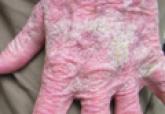Article

Crusted Scabies and Tinea Corporis After Treatment of Presumed Bullous Pemphigoid
We report a case of scabies that immunohistochemically mimicked bullous pemphigoid (BP) in an 82-year-old woman who presented with intractable...
Ms. Gyurjyan is from the University of Virginia School of Medicine, Charlottesville. Dr. Wilson is from the Department of Dermatology, University of Virginia Health System, Charlottesville.
The authors report no conflict of interest.
Correspondence: Barbara Wilson, MD, Department of Dermatology, University of Virginia Health System, PO Box 800718, Charlottesville, VA 22908-0718 (blw7u@virginia.edu).

An 81-year-old woman presented with a 2-cm erythematous, scaly, pruritic rash on the left dorsal wrist localized to the skin under her watch. The patient first noticed the lesion 2 months prior. She moved the watch to the right wrist a few days prior to presentation and no symptoms developed in that location. No other areas of the skin were affected. She had no known allergies and was otherwise in good health.
Although contact dermatitis from the metal on the back of the watch was suspected, many modern wrist watches are made with stainless steel rather than nickel, which is a common contact allergen; therefore, other diagnoses were considered in the differential including irritant contact dermatitis, psoriasis, and tinea infection. A potassium hydroxide (KOH) preparation was performed to rule out tinea infection. Unexpectedly, the KOH preparation was positive for fungal hyphae, confirming a diagnosis of tinea corporis. The patient was treated with clotrimazole cream 1% twice daily for 3 weeks during which time the rash completely resolved.
We present this case to stress the importance of performing KOH preparations even when the likelihood of tinea infection seems remote. At our institution, we teach our residents, “If it’s scaly, scrape it.” This adage has served us well. Tinea corporis may be mistaken for many other skin diseases, including eczema, psoriasis, and seborrheic dermatitis.1 A KOH preparation often is a helpful tool in confirming the diagnosis and should be performed when a dermatophyte infection is suspected. The KOH preparation is the most sensitive diagnostic test used to confirm dermatophyte infection, with 90% of infections showing positive results.2,3
Tinea infections may occur anywhere on the body, but areas that are prone to excessive heat and/or moisture are particularly susceptible.4 Dermatophyte infections typically present as annular, scaly, pruritic patches or plaques often with central clearing and an active border.1 In our patient, the lesion showed characteristics that were suggestive of a dermatophyte infection but was somewhat atypical in appearance, as it lacked central clearing (Figure). The 3 genera of dermatophytes—Trichophyton, Microsporum, and Epidermophyton—are common causes of fungal infections.2 The pathogenesis of dermatophytosis is the synthesis of keratinases that digest keratin and sustain the presence of the fungi. Local factors such as sweating and occlusion facilitate the activity of these organisms.2 In our case, the pathogenesis was believed to be due to the entrapment of moisture behind the patient’s watch, creating a favorable environment for fungal growth.

We report a case of scabies that immunohistochemically mimicked bullous pemphigoid (BP) in an 82-year-old woman who presented with intractable...
Mycosis fungoides is a cutaneous T-cell lymphoma. Its presence, which denotes an altered immune system, may make treatment of otherwise simple...
Two randomized, double-blind, vehicle-controlled, multicenter studies assessed the efficacy and safety of a new terbinafine 1% solution for the...
